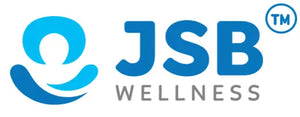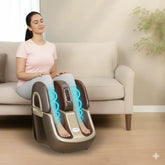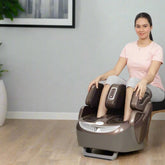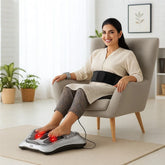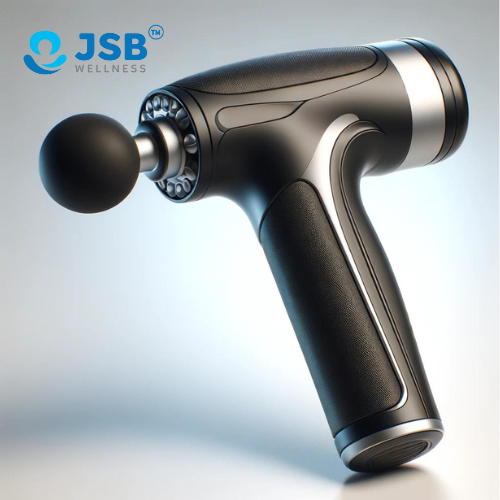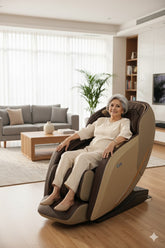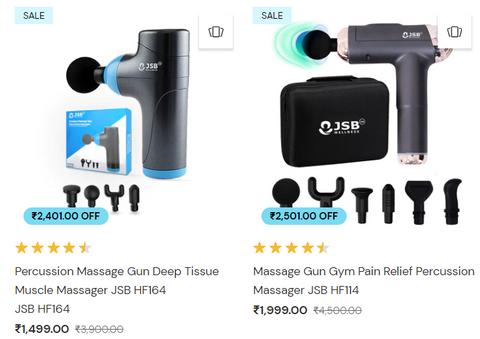Is massage gun good for back pain?
Introduction:
The exploration of modern solutions for managing back pain brings us to an intriguing device: the massage gun. This innovative tool has surged in popularity among athletes, fitness enthusiasts, and individuals seeking relief from muscle soreness and discomfort. But does it hold merit for those specifically suffering from back pain? In this blog, we delve into the effectiveness, usage, and scientific grounding behind massage guns as a remedy for back pain.
We'll examine how these devices work, their potential benefits, and considerations to keep in mind when using one. Whether you're a chronic back pain sufferer or simply looking for ways to ease post-workout tension, join us as we explore the potential of massage guns to provide relief and support your overall spinal health.
So, Is massage gun good for back pain?
Yes, a massage gun can be good for back pain, offering several benefits when used correctly. Here's a closer look at how it can help:
-
Muscle Relaxation and Tension Relief: Massage guns work by delivering rapid bursts of pressure into the muscle tissue, which can help to relieve muscle tension and spasms that often contribute to back pain.
-
Increased Blood Flow: The percussive therapy from massage guns increases circulation to the targeted area. Improved blood flow can help to reduce inflammation and promote healing, which is beneficial for those suffering from back pain.
-
Pain Relief: By directly targeting the areas of discomfort, massage guns can help to alleviate pain through mechanisms similar to traditional massage therapy, such as reducing muscle stiffness and enhancing range of motion.
-
Convenience and Accessibility: Massage guns offer a convenient way to manage back pain at home without the need for a professional massage therapist. This can be particularly useful for ongoing pain management and can be used as part of a comprehensive approach to back care.
-
Trigger Point Therapy: These devices can effectively target trigger points or “knots” in the muscles that are often sources of back pain. Regular use can help in breaking down these knots, offering long-term relief.
Considerations and Precautions
While massage guns can be beneficial for back pain, it's important to use them properly to avoid injury:
- Avoid Bones and Spine: Direct application on bones or the spine can be uncomfortable and potentially harmful. Focus on the muscle tissue surrounding these areas.
- Not for All Types of Back Pain: Those with acute injuries, herniated discs, or conditions like osteoporosis should consult with a healthcare provider before using a massage gun.
- Gradual Start: Begin with a lower intensity and gradually increase as tolerated to avoid excessive pressure that could lead to bruising or further injury.
- Duration and Frequency: Use the massage gun for short durations (a few minutes on each area) and avoid overuse on the same muscle groups to prevent irritation or muscle damage.
In summary, when used with proper technique and precautions, massage guns can be a valuable tool in the management of back pain. However, it's essential to consider them as part of a broader treatment plan, which may include physical therapy, exercise, and medical consultation, especially for chronic or severe conditions.
Do massage guns really work?
Massage guns have gained popularity as tools for muscle recovery, pain relief, and improving overall wellness through percussive or vibration therapy. They are designed to mimic the effects of deep tissue massage. Here's how they work and the evidence supporting their efficacy:
Mechanism of Action
- Percussive Therapy: Massage guns use rapid, repetitive strokes to penetrate deep into the muscle tissue, which can help to relieve muscle stiffness and soreness.
- Vibration Therapy: The vibrations from the massage gun can increase blood flow and warmth in the targeted area, aiding in muscle recovery and flexibility.
- Stimulation of the Nervous System: The pressure and vibration can also stimulate the nervous system, potentially reducing pain signals sent to the brain.
Evidence of Efficacy
- Muscle Recovery: Studies suggest that vibration therapy can be effective in reducing delayed onset muscle soreness (DOMS) and improving muscle performance after exercise.
- Pain Relief: While research is still emerging, early studies indicate that percussive therapy can help alleviate muscle pain, similar to traditional massage techniques.
- Flexibility and Circulation: Percussive and vibration therapies have been shown to improve range of motion and blood circulation, contributing to overall muscle health.
User Reports and Clinical Observations
- Positive Feedback: Many users report immediate relief from muscle soreness and improved recovery times after using massage guns. Athletes, in particular, have adopted these devices as part of their recovery routine.
- Professional Use: Physical therapists and sports medicine professionals increasingly incorporate massage guns into treatment plans, suggesting a level of clinical acceptance.
Limitations and Considerations
- Lack of Comprehensive Studies: While anecdotal evidence and preliminary studies are promising, more comprehensive research is needed to fully understand the benefits and limitations of massage guns.
- Not a Cure-All: Massage guns are most effective when used as part of a holistic approach to muscle recovery and pain management, including physical therapy, proper nutrition, and rest.
- User Dependence: Effectiveness can vary based on the user's ability to target the right muscles and use the device properly. Incorrect use may lead to injury or ineffectiveness.
In conclusion, massage guns appear to work for many people by providing relief from muscle soreness, improving circulation, and aiding in recovery. However, their effectiveness can depend on individual factors such as the specific muscle condition, the severity of pain or injury, and how the device is used. As with any therapeutic tool, it's advisable to use massage guns in conjunction with other treatments and consult with a healthcare professional if you have underlying health conditions or are recovering from injury.
Is it OK to use a massage gun?
Yes, it is generally OK to use a massage gun, provided it is used correctly and with certain precautions in mind. Massage guns are designed to provide percussive or vibration therapy, which can help relax muscles, improve blood circulation, and reduce pain. However, to ensure safety and effectiveness, here are some guidelines and considerations:
Guidelines for Safe Use
- Read the Manual: Before using a massage gun, it's crucial to read the manufacturer's instructions to understand how to use the device properly and safely.
- Start with Low Intensity: If you're new to using a massage gun, start with the lowest intensity to see how your body reacts before gradually increasing the intensity.
- Avoid Sensitive Areas: Avoid using the massage gun on sensitive areas, such as directly over bones, joints, the neck, or the lower back without muscle padding. Direct application on these areas can be painful and potentially harmful.
- Limit Usage Time: To prevent overuse, it's recommended to limit the use of the massage gun on any single muscle group to a few minutes at a time.
- Use on Soft Tissue Only: Focus on muscle groups and soft tissue, avoiding use on areas with poor circulation, wounds, or areas affected by recent surgery.
Considerations
- Medical Conditions: Individuals with certain medical conditions, such as vascular diseases, blood clotting disorders, or those who are pregnant, should consult with a healthcare provider before using a massage gun.
- Acute Injuries: For acute injuries, it's advisable to seek medical advice before using a massage gun, as it may not be suitable in the initial stages of injury.
- Pain and Discomfort: While some discomfort during muscle therapy is normal, you should stop using the device if you experience significant pain or discomfort.
Potential Benefits
- Muscle Recovery: Helps in muscle recovery post-exercise by reducing muscle soreness and improving blood circulation.
- Flexibility: Can increase flexibility by relaxing tight muscles and improving range of motion.
- Convenience: Offers a convenient way to receive muscle therapy at home without the need for a professional masseuse.
In summary, using a massage gun can be beneficial for muscle relaxation, pain relief, and improving blood circulation, but it's important to use it appropriately and be mindful of individual health conditions. When used correctly, it can be a valuable tool for managing muscle soreness and enhancing recovery.
What areas do massage guns target?
Massage guns are versatile tools designed to target various areas of the body for muscle relief and recovery. Their primary use is to alleviate muscle soreness, improve blood circulation, and enhance overall mobility through percussive or vibration therapy. Here's a look at the key areas they target:
-
Back and Shoulders: These are common areas of tension due to poor posture, prolonged sitting, or physical strain. A massage gun can help loosen tight muscles in the upper, middle, and lower back, as well as the trapezius muscles in the shoulders.
-
Legs and Glutes: For athletes or individuals who engage in frequent physical activity, the legs and glutes can often experience soreness. Massage guns are effective in targeting the quadriceps, hamstrings, calves, and gluteal muscles, aiding in recovery and reducing the risk of cramps.
-
Arms and Forearms: Repetitive motions or exercises can lead to tightness in the biceps, triceps, and forearm muscles. Using a massage gun on these areas can help relieve tension and prevent conditions like tennis elbow.
-
Neck: The neck can hold a lot of tension, leading to stiffness and pain. Carefully using a massage gun on the neck muscles can provide relief, but it’s important to use gentle settings to avoid discomfort.
-
Feet: Standing for long periods or intense foot workouts can cause discomfort. A massage gun can be used on the soles and heels to help with conditions like plantar fasciitis.
How to Use a Massage Gun Effectively
- Right Attachment: Use the appropriate attachment for the target area. For instance, larger, flatter heads for broader muscle groups and smaller, pointed tips for localized areas.
- Proper Technique: Move the massage gun slowly across the muscle group, avoiding bone and joints. Don't apply excessive pressure; let the device do the work.
- Timing: Use it for short periods (1-2 minutes on each muscle group) to avoid overstimulation or muscle damage.
Precautions
While massage guns can be beneficial, they're not suitable for everyone. Avoid using them on areas with injuries, inflammation, or skin conditions. People with certain health conditions (like blood clotting disorders, neuropathies, or pregnant women) should consult a healthcare provider before use.
In summary, when used correctly, massage guns can target a wide range of areas to alleviate muscle tension, enhance recovery, and improve mobility. However, it’s crucial to use them wisely and heed any relevant precautions to ensure their benefits are maximized without causing harm.
Conclusion on Is massage gun good for back pain :
In conclusion, massage guns can indeed be beneficial for individuals experiencing back pain, offering a convenient and effective way to alleviate muscle tension, improve blood flow, and enhance overall muscle recovery. By providing targeted, percussive therapy, these devices can help in managing and relieving back pain, especially when resulting from muscle stiffness, overuse, or minor strains.
However, it's crucial to recognize that massage guns are not a one-size-fits-all solution and may not be suitable for everyone. Individuals with certain medical conditions, acute injuries, or chronic pain should consult with healthcare professionals before incorporating a massage gun into their pain management routine. Proper usage, including the selection of appropriate attachments, adjusting the intensity to suit one's tolerance, and avoiding direct application on bones, joints, and sensitive areas, is essential to maximize benefits and minimize risks.
Furthermore, while massage guns can provide relief and assist in muscle recovery, they should be considered part of a broader approach to back pain management. This approach may include physical therapy, stretching exercises, proper ergonomics, and lifestyle modifications aimed at addressing the root causes of back pain.
In summary, when used judiciously and as part of a comprehensive pain management plan, massage guns can be a valuable tool for individuals looking to alleviate back pain, improve mobility, and enhance their quality of life.
